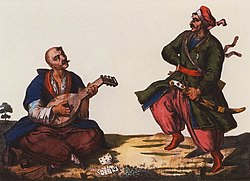Kobza: Difference between revisions
No edit summary |
|||
| (One intermediate revision by the same user not shown) | |||
| Line 28: | Line 28: | ||
==Etymology== |
==Etymology== |
||
[[Image:Kozak_Mamay.jpg|thumb|right.jpg|Kozak Mamai playing a kobza]] |
[[Image:Kozak_Mamay.jpg|thumb|right.jpg|Kozak Mamai playing a kobza]] |
||
The term ''kobza'' is first mentioned in Polish chronicles dating back to 1331, but lute-like instruments are known to have existed in the territories now known as Ukraine even earlier, either from the sixth century, brought there by [[Bulgars]], or possibly somewhat later by Polovetsians and [[Khazars]] |
The term ''kobza'' is first mentioned in Polish chronicles dating back to 1331, but lute-like instruments are known to have existed in the territories now known as Ukraine even earlier, either from the sixth century, brought there by [[Bulgars]], or possibly somewhat later by Polovetsians and [[Khazars]] <ref>http://torban.org</ref>. The term has a Turkic origin: "kobyz" or "khomus". The stringed folk instrument acquired widespread popularity in the 16th century, with the advent of the [[Hetmanate]] ([[Cossack]] state). |
||
The kobza was usually played by a bard or minstrel called ''[[kobzar]]'' (occasionally in earlier times a '''kobeznik'''), to accompany the recitation of a Ukrainian [[Epic poetry|epic]]s called ''[[duma (epic)|duma]]''. |
The kobza was usually played by a bard or minstrel called ''[[kobzar]]'' (occasionally in earlier times a '''kobeznik'''), to accompany the recitation of a Ukrainian [[Epic poetry|epic]]s called ''[[duma (epic)|duma]]''. |
||
| Line 46: | Line 46: | ||
==Bibliography== |
==Bibliography== |
||
<references/> |
|||
*Cherkasky, L., ''Ukrainski narodni muzychni instrumenty'', Tekhnika, Kyiv, Ukraine, 2003, 262 pp., ISBN 966-575-111-5 |
*Cherkasky, L., ''Ukrainski narodni muzychni instrumenty'', Tekhnika, Kyiv, Ukraine, 2003, 262 pp., ISBN 966-575-111-5 |
||
Revision as of 12:33, 7 December 2008
| File:Kobza.jpg.jpeg | |
| Other names | HS#:321.32-5 |
|---|---|
| Classification | |
| Related instruments | |

The term kobza refers to various musical instruments in eastern Europe.
- Hornbostel-Sachs classification number 321.32-5:
- The kobza (Ukrainian: кобза) is a traditional Ukrainian stringed musical instrument, of the lute family, and more specifically a relative of the Central European mandora.
- The cobza or cobsa is also a type of four-course (triple-strung courses) folk lute found primarilly in Romania and Moldova . Some courses had 3 strings. The cobza was tuned in fifths similar to the mandolin. In Hungary the same instrument is known as the koboz. Both are now increasingly rare.
- Hornbostel-Sachs classification number 321.321-5+6:
- The kobza was also a term for any regional lute-like instrument used by court musicians in Central-Eastern Europe, which might not have been a kobza proper. (This may be the Hungarian koboz)
- A term used for bagpipes and occasionally for the hurdy-gurdy in Eastern Poland, Belarus and Volyn in Ukraine.
- The term kobza was also used as a synonym for bandura in the 19th and early 20th century in Ukraine.
Etymology

The term kobza is first mentioned in Polish chronicles dating back to 1331, but lute-like instruments are known to have existed in the territories now known as Ukraine even earlier, either from the sixth century, brought there by Bulgars, or possibly somewhat later by Polovetsians and Khazars [1]. The term has a Turkic origin: "kobyz" or "khomus". The stringed folk instrument acquired widespread popularity in the 16th century, with the advent of the Hetmanate (Cossack state).
The kobza was usually played by a bard or minstrel called kobzar (occasionally in earlier times a kobeznik), to accompany the recitation of a Ukrainian epics called duma.
The kobza became extinct early in the 20th century. Currently there is a revival of kobza playing in Ukraine, due to the efforts of the "Kobzar Guild" in Kiev and Kharkiv.
The kobza was often referred to in historical sources as bandura (from Latin Pandura, via medieval Polish Barduny, i.e. a lute). The terms were interchangeable until about 1900. Eventually the unfretted "starosvitska" bandura (developed ca. 1800) appropriated the bandura name, but still was often referred to as kobza among the common folk, because of the name's historical cachet.
Types of Ukrainian kobzas

- Veresai kobza, (often referred to as authentic traditional kobza) with six treble strings strung along the treble side of the instrument. The instrument is played with the left hand pressing down on the strings against the fingerboard, which may or may not have frets.
- Orchestral kobza, with 4 strings tuned in fifths using tunings that parallel the violin family. The instruments are made in prima (soprano), alto and tenor and contrabass sizes.
- Accompaniment kobza, usually having 6 or 7 strings and a fretted neck. The six-string version uses standard guitar tuning. The 7-string version uses a Russian guitar (open G chord) tuning.
The kobza revival is impeded by the complete absence of the museum specimens. All evidence is entirely iconographic.
Bibliography
- Cherkasky, L., Ukrainski narodni muzychni instrumenty, Tekhnika, Kyiv, Ukraine, 2003, 262 pp., ISBN 966-575-111-5
